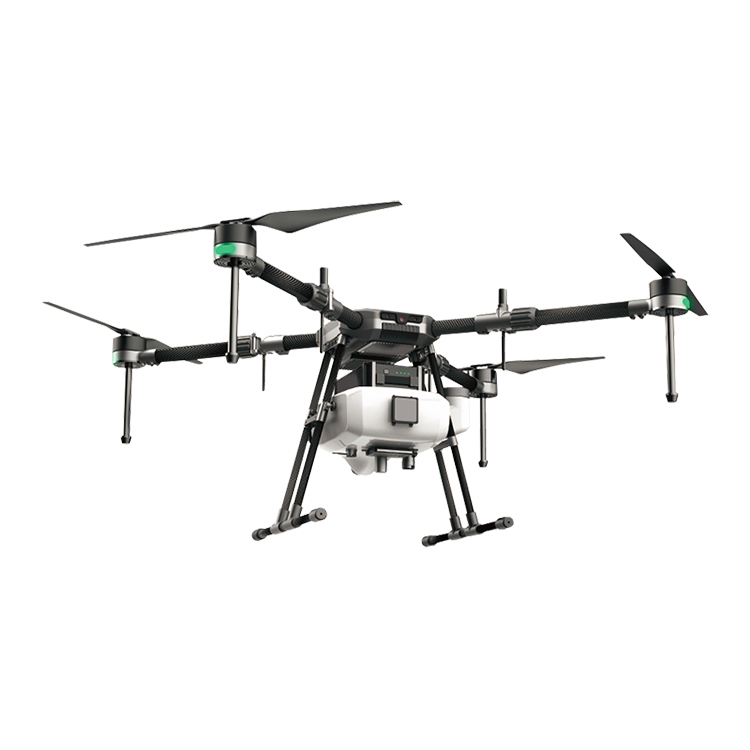he modern farmer knows that pests in the field are not a problem for the whole field. They are localized to certain areas. But because it's difficult to recognize where pests are located and target these areas, farmers — whether with ground rigs or crop dusters — tend toward a "full coverage" approach when it comes to pesticide application.
The battle to protect crops, however, is turning into an air war, one fought on smaller patches of ground.
On Monday, Lt. Gov. Adam Gregg got a first hand look at Rantizo, an Iowa City based drone company, that is approaching pesticides from the skies. The company is developing and testing drones equipped with cameras and pesticide applicators that aim to go where traditional ground spraying rigs cannot.
"When we are looking at Iowa, the move to drones will require a different cultural practice than current ground sprayer rigs," said Mike Schmitz, the director of technology for Rantizo. "The current practice is to do 100 percent coverage in a field; spray every last bit of it with pesticides. With drones, there will be more of a move to spot spraying."
In the future, farmers will be able to monitor fields, looking for where pests are and what kind they are, allowing them to better target specific infestation locations with just the right chemical.
"(Currently) it is easier to distribute a hundred gallons across an entire area than it is to distribute that chemical across particular areas," Schmitz said. For that, Rantizo is employing technologies that allow for a new approach to pest management.
One such technology is electrostatics. One of the problems with spraying is uneven coverage and over spraying resulting from row crop line spraying methods. Schmitz explained that the chemicals released from drones will actually hold a negative charge.
"(The chemical) repels itself which helps it disperse as it is coming out of the nozzle," Schmitz said. "When the droplet hits the leaf, the next droplet will land next to it; not in the same place as the first because of the nature of the charges between the two particles."
This method will lead to more even distribution. Which is important given that the models being tested will only carry approximately one gallon of chemical pesticide. Rantizo is trying to keep the drones fully loaded weight at 55 pounds. At higher limits, the FFA regulations for pilot training become more intense. Keeping chemical loads down helps keep weight down.
But with more targeted pesticide use comes higher concentrations of chemicals, and the current regulatory environment does have limits for pesticide concentration levels applied to crops.
"There are reasons why product labels are the way they are," Schmitz said. "They instruct the user how to apply that pesticide safely using the technologies they have. ... But some of the technologies that we are working with spray a chemical as safely and with as uniform of a pattern with less dilution. In some cases, less dilution than the label will allow for."
Iowa Lt. Gov. Adam Gregg, left, talks with Rantizo CEO Michael Ott, Monday, Feb. 25, 2019 at Rantizo in Iowa City, Iowa. Rantizo is a targeted drone sprayer company. (Photo: Joseph Cress/Iowa City Press-Citizen)
Lt. Gov. Adam Gregg said that the need to provide rural broadband connectivity is an important takeaway from his visit here.
"I heard about how they can leverage this technology by being able to use the data. But of course in order to use that, you've got to be able to get it out from the drone and get it out into a usable format," Gregg said. "Broadband is incredibly important to that."
The lieutenant governor also said that this more targeted approach to spraying and its potentially lower environmental impact holds promise for the future of Iowa agriculture.
"There is technology being developed that is going to be able to allow us to bring precision agriculture to the next level," Gregg said.
A DJI outfitted Rantizo drone sits in a back room on Monday, Feb. 25, 2019 at Rantizo's offices in Iowa City, Iowa. Rantizo is a targeted drone sprayer company. (Photo: Joseph Cress/Iowa City Press-Citizen)
This is why CEO Michael Ott said he was glad to have the second highest profile politician in the state checking out the progress Rantizo has made in its one year of operation.
"What we are doing didn't exist before," Ott said. "Sometimes it's not permitted. What we are saying is, 'This is a good idea. It's a derivative of what already exists. Let's find a way to make it work.'"
Ott said that working within the system while exploring its boundaries is part and parcel of what their research should be doing.
"If you try to do something too revolutionary, people will just shut down and say we can't do it," Ott said. "We are trying to be smart about it and thoughtful as we go out being really safe and dedicated. We want to have a great reputation and be good stewards about it."
SUPPORT LOCAL JOURNALISM:
Zachary Oren Smith writes about government, growth and development for the Press-Citizen. Reach him at zsmith@press-citizen.com or 319-339-7354, and follow him on Twitter @zacharyos.
Intelligent Agriculture is the trend of all over the world. And the intelligent drone act as a important role in this world plan.
Agriculture spraying drone can replace the traditional pesticide sprayer and it's speed is 40times of the traditional sprayer. It will save 90% water and 30%-40% pesticide. Small droplet diameter make the pesticide more well-distribute and improve the effect. At the same time, it will make the people faraway from the pesticide and reduce the pesticide remain of the crop.

Contact: Fly Dragon Drone Tech.
Email: frank at dronefromchina.com
Add: NO. 9 Dayu Road PiDu distric, ChengDu 611730, China